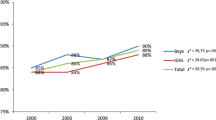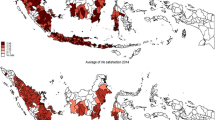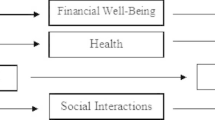Abstract
This paper explores family and non-family factors contributing to happiness among students aged 15–18 in Thailand. Data come from the Social and Cultural Situation and Mental Health Survey (n = 905). Based on regression analysis, family factors are more important than non- family factors in explaining the variations in adolescents’ happiness. Regarding the family domain, those who reported sufficient time spent with family members and highest level of love and connectedness were happiest. Those living in a two-parent family were happiest, followed by those living with a married father or a married mother (in a single parent family). Those living in an unmarried mother family were unhappiest, controlling for household economic status. These findings highlight the important role of a father in a country with a matrilocal family system. Regarding non-family factors, adolescents with the highest school attendance, highest self-esteem, and highest economic status who also regularly participated in extracurricular activities were happiest. Adolescents who were older and who had to do chores regularly tended to be less happy than their peers.
Similar content being viewed by others
References
Amato, P. R. (2001). Children of divorce in 1990 s: An updated of the Amato and Keith (1991) meta-analysis. Journal of Family Psychology, 15, 355–370.
Aseltine, R. H., Gore, S., & Colten, M. E. (1998). The co-occurrence of depression and substance use in late adolescence. Development and Psychopathology, 10, 549–570.
Bengtson, V. L. (2001). Beyond the nuclear family: The increasing importance of multigenerational bonds. Journal of Marriage of Family, 63, 1–16.
Bryceson, D., & Vuorela, U. (2002). Transnational families in the twenty-first century. In D. Bryceson & U. Vuorela (Eds.), The transnational family: New European frontiers and global networks (pp. 3–29). Oxford: Berg.
Cavanagh, S. (2008). Family structure history and adolescent adjustment. Journal of Family Issues, 29, 944–979.
Chan, Y. K., & Lee, R. P. L. (2006). Network size, social support and happiness in later life: A comparative study of Beijing and Hong Kong. Journal of Happiness Studies, 7, 87–112.
Crockett, L. J., Eggebeen, D. j., & Hawkins, A. J. (1993). Fathers’ presence and young children’s behavioral and cognitive adjustment. Journal of Family Issues, 14, 355–377.
Csikszentmihalyi, M., & Hunter, J. (2003). Happiness in everyday life: The uses of experience sampling. Journal of Happiness Studies, 4, 185–199.
Curran, S. R., Garip, F., Chung, C., & Tangchonlatip, K. (2005). The effects of gender on migration in Thailand. Social Forces, 84, 225–255.
Dalgas-Pelish, P. (2006). Effects of a self-esteem intervention program on school-age children. Pediatric Nursing, 32(4), 341–348.
Deleire, T., & Kalil, A. (2002). Good things come in threes: Single-parent multigenerational family structure and adolescent adjustment. Demography, 39, 393–413.
Demo, D. H., & Acock, A. C. (1996). Family structure, family process, and adolescents’ well-being. Journal of Research on Adolescence, 6, 457–488.
Department of Local Administration. (2007). Compilation of registration statistics 2007. http://www.dopa.go.th/web_pages/m03093000/services_files/modules50-1.xlls. Accessed 5 March 2010.
Easterlin, R. A. (2001). Income and happiness: Towards a unified theory. Economic Journal, 111, 465–484.
Easterlin, R. A. (2006). Life cycle happiness and its sources: Intersections of psychology, economics and demography. Journal of Economic Psychology, 27, 463–482.
Eshbaugh, E. M. (2008). Perceptions of family relationship factors and depressive symptoms in adolescents: What roles do parents and gender play? Journal of Child and Family Studies, 17, 127–139.
Feldman, S. S., Rubenstein, J. L., & Rubin, C. (1988). Depressive effect and restraint in early adolescents: Relationships with family structure, family process and friendship support. Journal of Early Adolescence, 8, 279–296.
Frey, B., & Slutzer, A. (2002). Happiness and economics. Princeton: Princeton University Press.
Gilman, R. (2001). The relationship between life satisfaction, social interest, and frequency of extracurricular activities among adolescent students. Journal of Youth and Adolescence, 30, 749–767.
Ginther, D. K., & Pollak, R. A. (2004). Family structure and children’s educational outcomes: blended families, stylized facts, and descriptive regressions. Demography, 41, 671–696.
Gray, R. S., & Chamratrithirong, A. (2009). Thailand. In E. B. Palmore, F. Whittington, & S. Kunkel (Eds.), International handbook on aging (pp. 563–578). Santa Barbara, California: LLC: ABC_CLIO.
Gray, R. S., Kramanon, R., & Thapsuwan, S. (2008a). The determinants of happiness among Thai people: Some evidence from Chai Nat and Kanchanaburi. Thammasat Economic Journal, 26, 72–87.
Gray, R. S., Rukumnuaykit, P., Kittisuksathit, S., & Thongthai, V. (2008b). Inner happiness among Thai elderly. Journal of Cross Cultural Gerontology, 23, 211–224.
Gray, R., Tantipiwatanaskul, P., & Suwannoppakao, R. (2010). Happiness among Thai people: Living a virtuous life, spirituality and self-esteem. Journal of Mental Health of Thailand, 18, 71–85.
Haire, E. C., Moore, K. A., Garrett, S. B., Ling, T., & Clieveland, K. (2008). The continued importance of parent-adolescent relationships during late adolescents. Journal of Research on Adolescence, 18, 187–200.
Harry, J. (1976). Evolving sources of happiness for men over the life cycle. Journal of Marriage and the Family, 38, 289–296.
Hofferth, S. L., & Anderson, K. G. (2003). Are all dads equal? Biology versus marriage as a basis for paternal investment. Journal of Marriage and the Family, 65, 213–232.
Huebner, E. S. (1994). Preliminary development and validation of a multidimensional life scale for children. Psychological Assessment, 6, 149–158.
Huebner, E. S., Drane, W., & Valois, R. F. (2000). Levels of demographic correlates of adolescent life satisfaction reports. School Psychology International, 21, 281–292.
Ingersoll-Dayton, B., Saengtienchai, C., Kespichayawattana, J., & Aungsuroch, Y. (2004). Measuring psychological well-being: Insights from Thai elders. The Gerontologist, 44, 596–604.
Jampaklay, A. (2006). Parental absence and children’s school enrollment. Asian Population Studies, 2, 93–110.
Jongudomkarn, D., & Camfield, L. (2006). Exploring the quality of life of people in northeastern and southern Thailand. Social Indicators Research, 78, 489–529.
Kandal, D. (1990). Parenting styles, drug use, and children’s adjustment of young adults. Journal of Marriage and Family, 52, 183–196.
Kemp, J. H. (1982). Kinship and locality in Hua Kok. Journal of Siam Society, 70, 101–113.
Kemp, J. (1991). The dialectics of village and state in modern Thailand. Journal of Southeast Asian Studies, 22, 312–326.
Kennedy, J. F., & Keeney, V. T. (1988). The extended family revisited: Grandparents rearing grandchildren. Child Psychiatry and Human Development, 19, 26–35.
Kinsella, K., & Phillips, D. R. (2005). Global aging: The challenge of success. Population Bulletin, 60, 5–42.
Knodel, J., Chamratrithirong, A., & Debavalaya, N. (1987). Thailand’s reproductive revolution rapid fertility decline in a third-world setting. Wisconsin: University of Wisconsin Press.
Knodel, J., Kespichayawattana, J., Wiwatwanich, S., & Saengtienchai, C. (2007). Migration and intergenerational solidarity: Evidence from rural Thailand. Bangkok: UNFPA Thailand.
Kohler, H., Behrman, J. R., & Skytthe, R. (2005). Partner + children = happiness? The effects of partnerships and fertility on well-being. Population and Development Review, 31, 407–445.
Kreider, R. M. (2008). Living arrangement of children: 2004. Suitland-Silver Hill: U.S Department of Commerce Economics and Statistics Administration, U.S Census Bureau.
Kwan, Y.-K. (2008). Life satisfaction and family structure among adolescents in Hong Kong. Social Indicators Research, 86, 59–67.
Kwan, Y.-K. (2010). Life satisfaction and self-assessed health among adolescents in Hong Kong. Journal of Happiness Studies, 11, 383–393.
Layard, R. (2005). Happiness: Lessons from a new science. New York: The Penguin Press.
Lu, L., & Lin, Y. Y. (1998). Family roles and happiness in adulthood. Personality and Individual Differences, 25, 195–207.
Mason, K. O. (1992). Family change and support of the elderly in Asia: What do we know? Asia Pacific Population, 7, 13–32.
McKeown, R. E., Garrison, C. Z., & Jackson, K. L. (1997). Family structure and cohesion, and depressive symptoms in adolescents. Journal of Research on Adolescence, 7, 267–281.
McLanahan, S., & Sandefur, G. (1994). Living with a single parent: What hurts, what helps?. Cambridge MA: Harvard University Press.
McLoyd, V. (1998). Socioeconomic disadvantage and child development. American Psychologist, 53, 185–204.
Nagar, S., Sharma, S., & Chopra, G. (2008). Self- esteem among rural girls. Anthropologist, 10, 151–154.
Noller, P. (1994). Personal relationships during adolescence. In R. Montemayor, G. R. Adams, & T. P. Gullotta (Eds.), Advance in adolescent development: An annual book series (pp. 37–77). Thousand Oaks, CA: Sage Publications.
Park, N., Huebner, E. S., Laughlin, J. E., Valois, R. F., & Gilman, R. (2004). A cross-cultural comparison of the dimensions of child and adolescent life satisfaction reports. Social Indicators Research, 66, 61–79.
Pattaravanich, U., Williams, L. B., Lyson, T. A., & Archavanitkul, K. (2005). Inequality and educational investment in Thai children. Rural Sociology, 70, 561–583.
Potter, S. H. (1992). Family life in a northern Thai village: a study in the structural significance of women. Berkeley: University of California Press.
Proctor, C. L., Linley, P. A., & Maltby, J. (2009). Youth life satisfaction: A literature review. Journal of Happiness Studies, 10, 583–630.
Putthisri, S., & Lotrakul, M. (2006). Adolescent suicides in Thailand during 1996–2003. Journal of Psychiatric Association of Thailand, 51, 21–28.
Raphael, D. (1996). Determinants of health of North-American adolescents: evolving definitions, recent findings, and proposed research agenda. Journal of Adolescent Health, 19, 6–16.
Rujiradarporn, N., & Trangkasombat, U. (2009). Depression in senior high school students in Bangkok Metropolis. Journal of Psychiatric Association of Thailand, 54, 337–346.
Sastre, M. T. M., & Ferriere, G. (2000). Family decline and the subjective well-being of adolescents. Social Indicators Research, 49, 69–82.
Seligson, J. L., Huebner, E. S., & Valois, R. F. (2003). Preliminary validation of brief multidimensional students’ life satisfaction scale (BMSLSS). Social Indicators Research, 61, 121–145.
Siyez, D. M. (2008). Adolescent self-esteem, problem behaviors, and perceived social support in Turkey. Social Behavior and Personality, 36, 973–984.
Steinberg, L., & Morris, A. (2001). Adolescent development. Annual Review of Psychology, 52, 83–140.
Storksen, I., Roysamb, E., Holman, T. L., & Tambs, K. (2006). Adolescent adjustment and well-being: Effects of parental divorce and distress. Scandinavian Journal of Psychology, 47, 75–84.
Suldo, S. M., & Huebner, E. S. (2004). Does life satisfaction moderate the effects of stressful life events on psychopathological behavior during adolescence? School Psychology Quarterly, 19, 93–105.
Sun, Y., & Li, Y. (2002). Children’s well–being during parents’ marital dissolution process: A pooled time-series analysis. Journal of Marriage and Family, 64, 472–488.
Swenson, R. R., & Prelaw, H. M. (2005). Ethnic identity, self-esteem, and perceived efficacy as mediators of the relation of supportive parenting to psychosocial outcomes among urban adolescents. Journal of adolescence, 28, 465–477.
Uchida, Y., Norasakkunkit, V., Kitiyama, S. (2004). Cultural constructions of happiness: Theory and empirical evidence. Journal of Happiness Studies, 223–239.
Veenhoven, R. (1997). Advances in understanding happiness. Revue Quebecoise de Psychologie 18, 29–74. http://www.eur.nl/fsw/personeel/happiness/. Accessed 20 February 2010.
Veenhoven, R. (2009). World database of happiness. Happiness scale interval study http://www.worlddatabaseofhappiness.eur.nl/scalestudy/scale_fp.htm. Accessed 28 August 2010.
Whitesell, N. R., Mitchell, C. M., & Spicer, P. (2009). A longitudinal study of self-esteem, cultural identity, and academic success among American Indian Adolescents. Cultural Diversity & Ethnic Minority Psychology, 15(1), 38–50.
World Bank Group. (2010). Thailand social monitor 2009: Towards a competitive higher education system in a global economy. http://siteresources.worldbank.org/INTTHAILAND/Resources/ch3.pdf. Accessed 17 June 2010.
Yeoh, B. S. A. (2009). Commentary making sense of “Asian” families in the age of migration. Asian Population Studies, 5, 1–3.
Zimmer, Z. (2003). A further discussion on revisiting the classification of household composition among elderly people. Journal of Cross Cultural Gerontology, 18, 247–250.
Zullig, K. J., Valois, R. F., Huebner, E. S., & Drane, J. W. (2005). Association among family structure, demographics, and adolescent perceived life satisfaction. Journal of Child and Family Studies, 14, 195–206.
Acknowledgments
This project is under the Program on Mental Health Promotion for the Well-Being of Thai People funded by the Thai Health Promotion Foundation. The authors would like to thank Dr. Prawate Tantipiwatanaskul, the manager of the Program, for his support and Dr. Peter Xenos for his suggestions on data analysis.
Author information
Authors and Affiliations
Corresponding author
Rights and permissions
About this article
Cite this article
Gray, R.S., Chamratrithirong, A., Pattaravanich, U. et al. Happiness Among Adolescent Students in Thailand: Family and Non-Family Factors. Soc Indic Res 110, 703–719 (2013). https://doi.org/10.1007/s11205-011-9954-y
Accepted:
Published:
Issue Date:
DOI: https://doi.org/10.1007/s11205-011-9954-y




